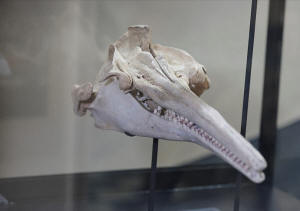|
Paleontologist Rodolfo Salas said the skull belonged to the
largest dolphin known to have inhabited the waters of South
America, measuring 3 to 3.5 meters long (9.8 to 11.4 feet). It
was named Pebanista yacuruna after the Yacuruna, a Peruvian
mythological being that lived in deep water.
"This dolphin is related to the dolphin of the Ganges river in
India," Salas said, adding the one found in Peru is much bigger
than its living relatives in Asia.
The ancestors of both dolphins formerly lived in the ocean,
Salas said.
"This allowed them to occupy large ocean spaces near the coasts
of India and South America. These animals lived in the
freshwater environments both in the Amazon and India. Sadly,
they became extinct in the Amazon, but in India they survived,"
Salas added.
The study was published in the journal Science Advances.
Scientists found the fossil during a 2018 expedition sponsored
by the National Geographic Society at the Napo River.
The Amazon and Orinoco river basins still are home to a species
known as the Amazon river dolphin, also called the pink river
dolphin or boto.
(Reporting by Anthony Marina, Alfredo Galarza, Enrique Mandujano,
Carlos Valdez, Nina Lopez; writing by Dave Gregorio; editing by
Will Dunham)
[© 2024 Thomson Reuters. All rights
reserved.]
Copyright 2022 Reuters. All rights reserved. This material may
not be published, broadcast, rewritten or redistributed.
Thompson Reuters is solely responsible for this content.

|
|




